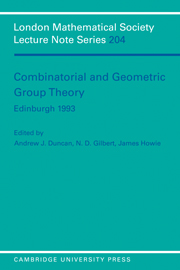Book contents
- Frontmatter
- Contents
- Foreword
- Participants
- On bounded languages and the geometry of nilpotent groups
- Finitely presented groups and the finite generation of exterior powers
- Semigroup presentations and minimal ideals
- Generalised trees and Λ-trees
- The mathematician who had little wisdom: a story and some mathematics
- Palindromic automorphisms of free groups
- A Freiheitssatz for certain one-relator amalgamated products
- Isoperimetric functions of groups and exotic cohomology
- Some embedding theorems and undecidability questions for groups
- Some results on bounded cohomology
- On perfect subgroups of one-relator groups
- Weight tests and hyperbolic groups
- A non-residually finite, relatively finitely presented group in the variety N2A
- Hierarchical decompositions, generalized Tate cohomology, and groups of type (FP)∞
- Tree-lattices and lattices in Lie groups
- Generalisations of Fibonacci numbers, groups and manifolds
- Knotted surfaces in the 4-sphere with no minimal Seifert manifolds
- The higher geometric invariants of modules over Noetherian group rings
- On calculation of width in free groups
- Hilbert modular groups and isoperimetric inequalities
- On systems of equations in free groups
- Cogrowth and essentiality in groups and algebras
- Regular geodesic languages for 2-step nilpotent groups
- Finding indivisible Nielsen paths for a train track map
- More on Burnside's problem
- Problem Session
Generalised trees and Λ-trees
Published online by Cambridge University Press: 05 April 2013
- Frontmatter
- Contents
- Foreword
- Participants
- On bounded languages and the geometry of nilpotent groups
- Finitely presented groups and the finite generation of exterior powers
- Semigroup presentations and minimal ideals
- Generalised trees and Λ-trees
- The mathematician who had little wisdom: a story and some mathematics
- Palindromic automorphisms of free groups
- A Freiheitssatz for certain one-relator amalgamated products
- Isoperimetric functions of groups and exotic cohomology
- Some embedding theorems and undecidability questions for groups
- Some results on bounded cohomology
- On perfect subgroups of one-relator groups
- Weight tests and hyperbolic groups
- A non-residually finite, relatively finitely presented group in the variety N2A
- Hierarchical decompositions, generalized Tate cohomology, and groups of type (FP)∞
- Tree-lattices and lattices in Lie groups
- Generalisations of Fibonacci numbers, groups and manifolds
- Knotted surfaces in the 4-sphere with no minimal Seifert manifolds
- The higher geometric invariants of modules over Noetherian group rings
- On calculation of width in free groups
- Hilbert modular groups and isoperimetric inequalities
- On systems of equations in free groups
- Cogrowth and essentiality in groups and algebras
- Regular geodesic languages for 2-step nilpotent groups
- Finding indivisible Nielsen paths for a train track map
- More on Burnside's problem
- Problem Session
Summary
1. The idea of a Λ-tree, where Λ is an ordered abelian group, was introduced in [9]. We shall reproduce the definition shortly, but for an account of the basic theory of Λ-trees we refer to [1]. In the special case Λ = ℤ, ℤ-trees are closely related to simplicial trees (trees in the ordinary graph-theoretic sense). The connection is spelt out in Lemma 4 below, which shows that Λ-trees may be viewed as generalisations of simplicial trees. However, there are other notions of generalised tree in the literature, and our purpose here is to consider two of these, and their relation to Λ-trees.
Firstly there is what we call an order tree. This is a partially ordered set {P, ≤) such that the set of predecessors of any element is linearly ordered, that is, for all x, y, z ∈ P, if x ≤ z and y ≤ z, then either x ≤ y or y ≤ x. It is also convenient to assume that P has a least element (this can always be arranged just by adding one). By choosing a point in a Λ-tree, it is possible to make the Λ-tree into an order tree. We shall show that, conversely, any order tree (P, ≤) can be embedded in a Λ-tree for some suitable Λ, so that the ordering on P is induced from the ordering on the Λ-tree defined by the (image of) the least element of P.
- Type
- Chapter
- Information
- Combinatorial and Geometric Group Theory, Edinburgh 1993 , pp. 43 - 55Publisher: Cambridge University PressPrint publication year: 1994
- 2
- Cited by



